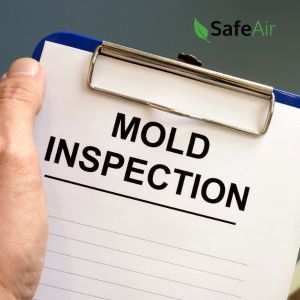The Impact of Mold on Indoor Air Quality
Posted in Mold, on June 12, 2024
We’re fanatics for fresh and clean home air quality at SafeAir, and for many of our clients, the first stop on their journey towards a healthier home is mold inspection in Toronto. Mold spores are among the top allergens affecting homes across the GTA, and specialized indoor air quality testing is often the only way to know if you’re impacted.
The impact of mold growth on indoor air quality cannot be understated — it’s a pervasive issue that affects, to some extent, almost every home we visit. But the good news is that solutions are within reach and, caught early, won’t break the budget either. In today’s article, the SafeAir team will share how mold impacts indoor air quality and why you should consider air quality testing this spring.
 Understanding Mold Spores
Understanding Mold Spores
We’ll start with the basics: what are mold spores, and how do they affect indoor air quality? Spores are the reproductive arm of a mold colony; mold is a fungus, and instead of producing seeds, they create spores, which float through the air like dandelions’ fluffy seed heads do. Unlike the visible seeds of flowers, however, mold spores are so tiny that they’re invisible and easy to breathe in. Spores can also settle on skin, eyes, and mucous membranes, causing irritation and inflammation.
Mold spores appear on indoor air quality testing even if there are no visible or physical symptoms of an infestation. Mold can grow quietly behind walls or in the attic, making visual detection impossible or unlikely, making air quality testing one of the best ways to assess your risk.
How Mold Impacts Air Quality
After over a decade of experience helping families improve their indoor air quality, we’ve noticed six primary impacts of mold growth at home:
1. Health Risks
Just as folks can be allergic to dust, so too can they be allergic to mold. Mold causes a range of common symptoms similar to the cold and flu — in fact, if you seem to suffer from an ongoing cough or cold, the cause may not be viral! Coughing, sneezing, itchy eyes, and headaches are some everyday ways mold irritates the body. While these may seem minor in the short term, everyday exposure can weaken the immune system and begin affecting sleep and work, too.
2. Toxic Spores
Some types of mold create mycotoxins that cause much more severe effects and consequences than allergic reactions. Mycotoxins affect the brain and nervous system, and exposure to these toxic particles has been linked with death and severe illness. While Stachybotrys Chartarum, or toxic black mold, is commonly named as the biggest culprit, many types of molds create mycotoxins. We can test for mycotoxin-producing mold!
3. Respiratory Issues
When breathed in, mold spores settle in the nose, mouth, and respiratory system. For healthy people, this may cause some coughing and irritation, but for people with ongoing respiratory conditions, exposure may cause acute issues or flare-ups. Exposure to mold in childhood has been linked to the development of asthma and has been found to cause more frequent attacks and flare-ups.
4. Odours and Allergens
The smell of mold growth is distinct and smells similar to rotting leaves. This musty, damp odour is often the only physical sign that you need mold removal, but even still — it’s not always present. Your home shouldn’t have a strong or unusual odour; if it does, air quality testing can help you unearth the cause.
5. Structural Damage
Mold eats away at wood, paper, textiles, and other organic materials. Unfortunately, our homes are made up of these materials. As it munches away on your home, mold weakens its structure and can cause costly damage and unsightly marks.
6. Long-Term Effects
While there’s still much to learn about mold exposure's long-term effects, we know that the impact on you begins early. For example, many SafeAir clients report poor or disrupted sleep, leading to fatigue and poor energy levels, reducing your quality of life and productivity. Magnified over many years or decades, mold or poor air quality, both solvable problems, can quickly have an outsized effect.
Work with SafeAir For Better, Healthier, Air Quality
Mold is a common problem in Toronto in part because our climate supports year-round growth: mold naturally thrives during the hot and humid summer months, and during the winter, we artificially heat and humidify our homes for our own comfort — and mold’s, too.
Preventing mold growth and remaining comfortable indoors is a balancing act that SafeAir can help you achieve with mold inspection in Toronto. We’ll assess your home for risk factors, visible growth, and hidden spores, identifying air quality issues, like poor ventilation, that may contribute to mold growth or poor air quality. What’s terrific about indoor air quality testing in Toronto is that you can implement many small solutions without costly interventions or equipment — making it a no-brainer health solution for your whole home. Contact SafeAir today for a free quote.

